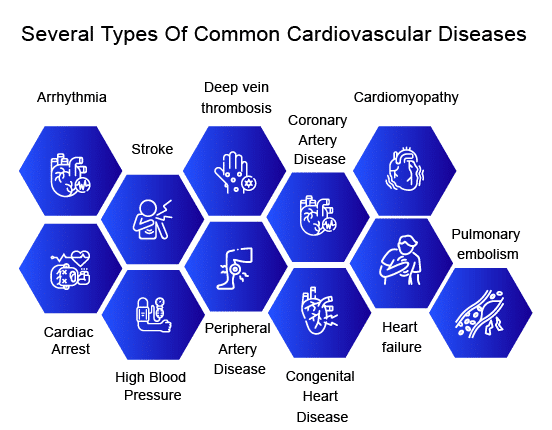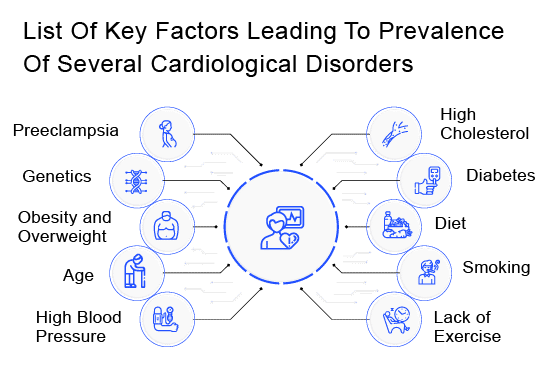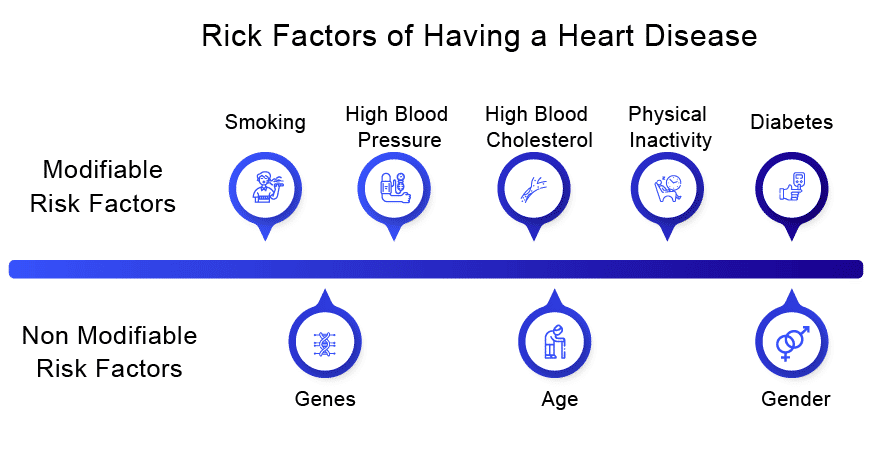Rising Global Prevalence of Cardiovascular Diseases And Top Players In Cardiology
Jan 31, 2022
Table of Contents
Cardiovascular Diseases (CVDs), primarily constituting heart failure, ischemic heart disease, stroke, are considered as leading global cause of mortality and a major contributor to disability. Over the last 30 years, deaths and disabilities from Cardiovascular Disease have been steadily rising across the globe. Cardiovascular Disease such as heart disease and stroke was responsible for a staggering one-third of all deaths worldwide. In addition to that, when the world got struck from the COVID-19 pandemic, Cardiovascular Disease quickly emerged as a major risk factor for severe cases which often ended in hospitalization and death.
As per WHO, an estimated 17.9 million people died from Cardiovascular Disease in 2019, representing 32% of all global deaths. Of these deaths, 85% were due to heart attack and stroke. Cardiovascular diseases can be prevented by addressing behavioural risk factors such as tobacco use, unhealthy diet and obesity, physical inactivity and harmful use of alcohol. It is important to detect cardiovascular disease as early as possible so that management with counselling and medicines can begin. Some of the most common types of Cardiovascular Diseases include Arrhythmia, Cardiac Arrest, High Blood Pressure, Stroke, Peripheral Artery Disease, Coronary Artery Disease, Heart failure, Cardiomyopathy, Congenital Heart Disease, Deep vein thrombosis, Pulmonary embolism, and many others.
Downloads
Article in PDF
Recent Articles
- Invokana matches; Xultophy beats; Lilly and BI follow; Tresiba matches
- GSK’s RSV Vaccine Clears Phase III Test in Adults; Roche’s Tecentriq for Adjuvant NSCLC; Owkin Ba...
- Rapid Medical’s TIGERTRIEVER 13; Glaukos’s Istent Infinite System; GE Healthcare’s Definium 656 H...
- With advancements in Innovative Technology, Cardiac Monitoring Devices Market is Booming Signific...
- Check-Cap’s Pivotal Trial for C-Scan; Curebase and Flow Neuroscience’s tDCS Device; Brainlab Acqu...
A heart attack or stroke may be the first sign of Cardiovascular Disease. Symptoms of Cardiovascular Disease include pain or discomfort in the centre of the chest, pain or discomfort in the arms, the left shoulder, elbows, jaw, or back. In addition to these symptoms, difficulty in breathing or shortness of breath can also be experienced, nausea or vomiting, light-headedness or faintness, a cold sweat and turning pale. Other common Cardiovascular Disease symptoms include sudden onset of numbness of the face, arm, or leg, especially on one side of the body, confusion, difficulty speaking or understanding speech, difficulty seeing with one or both eyes, difficulty walking, dizziness and/or loss of balance or coordination, severe headache with no known cause, and fainting or unconsciousness. Anyone experiencing these specific set of symptoms should seek medical care immediately.

Risk Factors Accountable For Increasing Cardiovascular Diseases Prevalence
The most important behavioural Cardiovascular Diseases risk factors are unhealthy diet, physical inactivity, tobacco use and harmful use of alcohol. The effects of behavioural risk factors may show up in individuals as raised blood pressure, raised blood glucose, raised blood lipids, and overweight and obesity. Cessation of smoking, tobacco use, reduction of salt in the diet, eating more fruit and vegetables, regular physical activity and avoiding harmful use of alcohol have been shown to reduce the risk of Cardiovascular Diseases.
Following is the list of Cardiovascular Diseases risk factors responsible for rising prevalence-
Smoking/Tobacco Use
Tobacco use is the leading cause of disability-adjusted life-years. Globally, smoking is the second-leading cause of death, accounting for 8.1 million deaths worldwide in 2017. Over the past 7 years, there has been a sharp increase in electronic cigarette use among adolescents, and electronic cigarettes are also commonly used tobacco product. Although there has been a consistent decline in adult and youth cigarette, significant disparities still persist. Smoking is considered to be a major Cardiovascular Disease cause and is definitely a modifiable risk factor. Smoking or tobacco consumption causes approximately one of every four deaths from CVD, chemicals in cigarette smoke cause the cells that line blood vessels to become swollen and inflamed. This can narrow the blood vessels and can lead to many cardiovascular conditions.
Physical Inactivity
The prevalence of self-reported physical inactivity has declined sharply among adults, even decreasing below the target for that is meant for healthy people, according to a survey by WHO. Being inactive can lead to fatty material building up in the arteries. If the arteries that carry blood to the heart gets damaged and clogged, it can lead to a heart attack. Physical activity is considered to be one of the most modifiable risk-factors of Cardiovascular Disease.
Nutrition
Diet is an important Cardiovascular Disease risk factor. A healthy diet score has been observed to improve in recent years, although disparities still persisted. Improvements were largely attributable to increased consumption of whole grains, nuts, seeds, and legumes, as well as decreased consumption of sugar-sweetened beverages. Food-related risk factors include obesity, high blood pressure, uncontrolled diabetes and a diet high in saturated fats. A low-saturated fat, high-fibre, high plant food diet can substantially reduce the risk of developing heart disease. A healthy nutritious diet is once again considered a much modifiable risk factor.
Overweight/Obesity
Firstly, obese individuals tend to have greater amounts of blood, which makes the heart pump harder and can lead to heart failure over time. The fundamental cause of obesity and overweight is an energy imbalance between calories consumed and calories expended. Globally, there has been an increased intake of energy-dense foods that are high in fat and sugars leading to increase in obesity worldwide. In overweight and obese individuals, weight loss may improve insulin sensitivity, leading to reduction in Cardiovascular Diseases risk factors and, consequently, the potential for cardiovascular events. Hence, it is also a modifiable risk factor for Cardiovascular Disease.
High Blood Cholesterol and Other Lipids
In recent years, the proportion of youths consuming total cholesterol, high-density lipoprotein cholesterol, and non–high-density lipoprotein cholesterol increased significantly. When there is too much cholesterol in the blood, it builds up in the walls of arteries, causing a process called atherosclerosis, an atherosclerotic cardiovascular disease. The arteries become narrowed and blood flow to the heart muscle is slowed down or blocked. Body do require cholesterol to build healthy cells, but high levels of cholesterol can increase the risk of Cardiovascular Disease. With high cholesterol, fatty deposits can be developed in the blood vessels. Eventually, these deposits grow, making it difficult for enough blood to flow through the arteries. Another modifiable Cardiovascular Disease risk factor, high blood cholestrol can be controlled by limiting saturated fats, foods high in sodium, and added sugars, eating plenty of fresh fruit, vegetables, and whole grains can help lower the blood pressure and cholesterol, two things that can lower the risk of Cardiovascular Disease.

High Blood Pressure
Increase in blood pressure is becoming very common nowadays. High blood pressure can damage the arteries by making them less elastic, which decreases the flow of blood and oxygen to heart and leads to heart disease. In addition, decreased blood flow to the heart can cause chest pain, also known as angina. High blood pressure is a common cause of Cardiovascular Disease but is a modifiable risk factor and can often be prevented by eating healthily, maintaining a healthy weight, taking regular exercise, drinking alcohol in moderation and not smoking.
Diabetes Mellitus
An estimated 26 million adults have been diagnosed with Diabetes Mellitus and 91.8 million adults have prediabetes. Diabetes Mellitus is a well-established Cardiovascular Disease risk factor. People with type 2 Diabetes Mellitus (T2DM) have a higher cardiovascular morbidity and mortality. Over time, high blood sugar can damage blood vessels and the nerves that control heart. Excess blood sugar decreases the elasticity of blood vessels and causes them to narrow, impeding blood flow. This can lead to a reduced supply of blood and oxygen, increasing the risk of high blood pressure and damage to large and small blood vessels. People with diabetes are also more likely to have other conditions that raise the risk for Cardiovascular Disease.
Kidney Disease
The overall prevalence of chronic kidney disease has increased in past few years, and it is a severe risk factor for incident and recurrent coronary events, stroke, venous thromboembolism, and atrial fibrillation. When the kidneys are not working well, the hormone system responsible for regulating blood pressure, has to work harder to increase blood supply to the kidneys. When this happens, the heart has to pump harder, which can lead to heart disease. The association of reduced estimated glomerular filtration rate with cardiovascular risk is generally similar across age, race, and sex subgroups. Although it is difficult to modify kidney disease, lifestyle modifications including smoking cessation, intentional weight loss, and regular physical activity can still prevent the risk of Cardiovascular Disease.

Top Cardiology Companies Dedicated To Improve Cardiovascular Disease Treatment
Cardiology remains one of the biggest pharmaceutical drug sales segment in the overall drug sales segment. Cardiology companies are putting a heavy focus on the anti-thrombotic segment, as these drugs continue to bring in the biggest profit and dominate the Cardiovascular market. In addition to that, Cardiology is also observed to be the second-biggest medical device area by sales. More than one in every 10 medical devices sold is a cardiovascular device.

Top Cardiology companies working in the cardiovascular drug development and marketing include names such as Sanofi, Bayer, Bristol-Myers Squibb Co, Novartis, Daiichi Sankyo Co Ltd, Pfizer, Johnson & Johnson, AstraZeneca, Gilead Sciences, GlaxoSmithKline, Amgen, Merck & Co, Abbott Laboratories, Takeda Pharmaceuticals, Regeneron, United Therapeutics, and many more. Other key cardiology device companies which are involved in developing cardiovascular medical devices include names like Medtronic, St. Jude Medical, Boston Scientific, Edwards Lifesciences, Abbott Laboratories, Johnson & Johnson, Getinge, Terumo, W. L. Gore & Associates, Lepu Medical Technology, and several others.
Reduction of Cardiovascular Disease Burden
The key to Cardiovascular Disease burden reduction lies in the inclusion of cardiovascular disease management interventions in universal health coverage packages, although in a high number of countries health systems require significant investment and reorientation to effectively manage Cardiovascular Disease. Evidence from several countries have shown that hypertension programmes can be implemented efficiently and cost-effectively at the primary care level which will ultimately result in reduced Cardiovascular Diseases. Patients with Cardiovascular Disease should have access to appropriate technology and medication.
Basic medicines that should be available include aspirin, beta-blockers, angiotensin-converting enzyme inhibitors, and statins. Also, an acute event such as a heart attack or stroke should be promptly managed. Sometimes, surgical operations are required for Cardiovascular Disease treatment. They include coronary artery bypass, balloon angioplasty, valve repair and replacement, heart transplantation, and artificial heart operations. Medical devices are also required to treat some Cardiovascular Diseases. Such devices include pacemakers, prosthetic valves, and patches for closing holes in the heart.
There are also a number of underlying determinants of Cardiovascular Diseases. These are a reflection of the major forces driving social, economic and cultural change – globalization, urbanization and population ageing. Other determinants of CVDs include poverty, stress and hereditary factors.

Way Ahead
Cardiovascular Diseases remain the leading cause of disease burden in the world. CVD burden continues its decades-long rise for almost all countries outside high-income countries, and alarmingly, the age-standardized rate of CVD has begun to rise in some locations where it was previously declining in high-income countries. There is an urgent need to focus on implementing existing cost-effective policies and interventions if the aim is to reduce the increasing Cardiovascular Diseases prevalence worldwide.
Downloads
Article in PDF
Recent Articles
- Miracor Medical’s Picso Pivotal Study; Medtronic’s Extravascular ICD; Galaxy Medical’s CENTAURI P...
- What are the Top Five Leading Causes of Deaths in the World?
- Medtronic Launches Infusion Set for Insulin Pumps; Penumbra’s Virtual Reality-Based Rehabil...
- GE and Medtronic’s Collaboration; Vivalink’s Multi-Vital Blood Pressure Patch; Foldax...
- Major Drugs Decisions for Cardiovascular Diseases to Watch Through 2022



